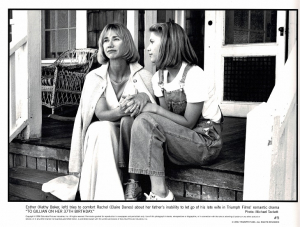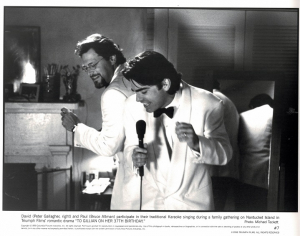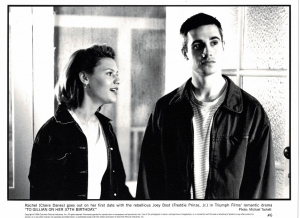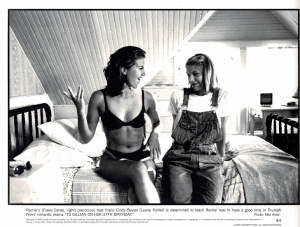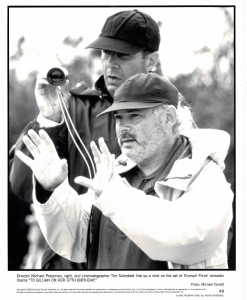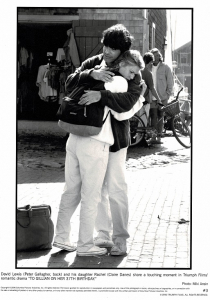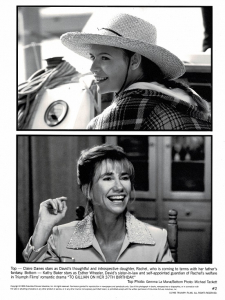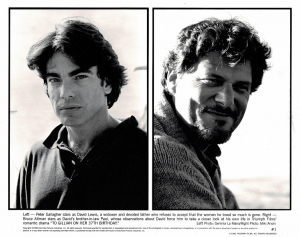To Gillian on Her 37th Birthday
“TO GILLIAN ON HER 37TH BIRTHDAY”
Production Information
Labor Day weekend on Nantucket Island marks a family reunion for David Lewis (Peter Gallagher) and his teenage daughter, Rachel (Claire Danes) along with his sister-in-law Esther (Kathy Baker) and brother-in-law Paul (Bruce Altman). It also marks the anniversary of David’s wife Gillian (Michelle Pfeiffer) who died in a boating accident on her birthday two years ago. To David, it could have been yesterday. Hoping to help David overcome his grief, Paul and Esther bring an attractive single woman (Wendy Crewson) with them to the island. But he’s not over Gillian. In fact, David is completely in love with her. It’s as though the strength of his devotion just might bring her back.
As the family celebrates the weekend with the traditional karoake singing and a sand castle competition, relationships are re-examined and truths are revealed. When David discovers that his obsession with his late wife has damaged his precious relationship with Rachel, he realizes he must do everything in his power to regain his daughter’s love — even if it means letting go of Gillian.
A Rastar/David E. Kelley Production for Triumph Films, “To Gillian on Her 37th Birthday” is a romantic-drama about life, relationships and enduring love. It stars an ensemble cast including Peter Gallagher, Claire Danes, Kathy Baker, Wendy Crewson, Bruce Altman, Laurie Fortier, Freddie Prinze, Jr. and Michelle Pfeiffer.
The film was directed by Michael Pressman and produced by Marylcay Powell, president of Rastar, and David E. Kelley. “To Gillian on Her 37th Birthday” marks the first foray into feature film producing and writing for Kelley, creator and executive producer of the acclaimed television series “Picket Fences” and “Chicago Hope.” His screenplay was based
on the play by Michael Brady.
ABOUT THE STORY
How do we deal with inexorable loss – the death of a loved one, or a person who is unattainable? Where do we find the strength to go on; and, what happens if we don’t?
“The idea of letting go of these kinds of losses is a very big challenge,” comments “To Gillian on Her 37th Birthday” producer Maiykay Powell. “I think the film is about the fear of letting go. If you do let go of the dream, it may invalidate it; if you let go of a dead person, perhaps you are disloyal to that person. Finding a way to move on and keep the love is an enormous challenge that is inescapable.”
For director Michael Pressman, the film is “about coming to terms with how you say goodbye to someone you love. This could be the ending of a marriage, the ending of a romance, or the ending of a friendship. The hardest thing is saying goodbye. David has to find a way to finally say goodbye to his dead wife and honor and remember her in a very real way. The story is really about a celebration of life. It’s painful, heartwarming and ultimately uplifting.”
Widower David Lewis knows that his wife is physically dead, but he refuses to let go of her ethereal, luminous presence. He converses with her in the moonlight, frolics and
laughs with her on the beach and shares his undying love; isolating himself and ostracizing his daughter Rachel from himself and the grieving process. He’s happier when he’s with Gillian, and mistakenly believes that he is doing the right thing for everyone. “Gillian is very much alive to David,” says Peter Gallagher of his character, “and he fmds a certain kind of solace and guidance from her in terms of raising their adolescent daughter.
“In his mind, love doesn’t die with the person,” continues Gallagher. “Love is a feeling and fantasy is part of our lives. He’s having an emotional fantasy. What harm is it doing anyone if it helps him get out of bed in the morning and function? But in his effort to protect Rachel, he realizes she feels excluded from her only remaining parent. There is no choice left but to have to say goodbye to Gillian and move on.”
Sixteen-year-old Rachel Lewis remembers the strong and powerful love her parents had, but “she feels her father is being selfish since the whole family has to deal with Gillian’s death. Their grieving is overshadowed by his despair,” says Claire Danes. “He’s shutting himself off from everybody else, including his daughter and she feels a little neglected.
There’s a tinge of jealousy because Rachel is alive and wants more attention than a dead person. She really wants things to be normal again so she can feel secure.”
Gillian’s sister Esther has her own way of dealing with her grief. “She’s taking psychology classes, trying to learn about herself and about family relations,” says Kathy Baker. “Esther is quite straightforward about the need for David to face the truth that his wife has died. It’s not good for his daughter that he’s spending so much time in fantasy land and not parenting. It not a very healthy place for a sixteen-year-old. She feels that enough is enough.”
Esther and her husband Paul travel to Nantucket Island for the family’s end-of-summer revelry. The weekend still includes the traditional activities that Gillian always planned for the family: a black-tie dinner, a sand castle competition, and a Karaoke singalong. Esther, however, is concerned about David’s state of mind and his behavior convinces her that her worst suspicions are true – David needs help and she must take action to remove Rachel from an unhealthy situation. She threatens to take legal custody of her niece, becoming the catalyst that forces David to confront reality and make a decision.
Esther and Paul also have another way of pulling David out of his shell – they bring along their friend — an attractive, intelligent woman named Kevin. Of course, they haven’t informed David of the surprise.
When Kevin learns the circumstances of Gillian’s tragic death two years ago on this weekend, “all she wants to do is stay on the ferry and go back to the mainland to get out of this situation,” says Wendy Crewson. “She is somehow cajoled off the boat into this hornet’s nest of emotion and accusation, and is surrounded by this lunatic family.
“I think she becomes involved with what goes on,” adds Crewson. “She’s quite taken with Rachel’s plight of being caught in this terrible mess between her aunt and her father.
She’s also vaguely intrigued by David and his situation of holding this love for Gillian. Kevin is quite cynical about love when she enters and a little more optimistic about it when she leaves.”
As the weekend progresses, relationships are examined and truths are revealed. As David’s mind continues to play tricks on him, he remembers the romantic perfection of his love for Gillian. Meanwhile, Esther and Paul become a little envious of such an enduring love.
In his reticence to express his feelings to Esther, Paul is the cynical antithesis of David.
When Rachel’s precocious friend Cindy, played by Laurie Fortier, confronts him with a provocative proposal, Paul is forced to take a hard look at his own life. “She mocks him and then comes on to him,” comments Bruce Altman. “He doesn’t act upon it, but it causes him to question what he really wants. He realizes that he has wounded his wife and that he really loves her and needs her.”
“This is a weekend where Esther and Paul finally express their appreciation for each other,” adds Baker. “Their relationship might not be Gillian’s and David’s and it might not be anyone else’s idea of the perfect one, but it’s theirs. It’s special and this weekend they tell
each other how much they appreciate it.”
For Rachel’s sake, David finally realizes that he is strong enough to let go of his fantasies of Gillian and rejoin the living. He bids his life companion a final farewell with the words, “I love you forever and ever.”
ABOUT THE PRODUCTION
In 1985, Michael Pressman directed the West Coast premiere of Michael Brady’s play “To Gillian on her 37th Birthday.” The Los Angeles production received five Los Angeles Critics Circle Award nominations.
“I fell in love with the play and have always wanted to make it as a movie,” notes Pressman. “After ten years of waiting and loving a project, this is a dream come true.”
Rastar Productions had owned the play for a few years, and after several attempts to adapt it to a screenplay, producer Marykay Powell approached Pressman to direct the film
Since Pressman had been working with David E. Kelley on the television series “Picket Fences” and “Chicago Hope,” the two thought the material would be very apt for him. When Kelley agreed to write the screenplay, the pieces quickly fell in place for the project to go into
production. David Saunders, president of Sony’s Triumph Films, agreed to finance the film through his division.
“It was a very contemporary situation that could be made complex and interesting with Kelley’s input,” Powell says. “By the time he was ready to think about doing a screenplay, there we were. Indeed the material appealed to David and I think he saw the complexity of it.
I think that David Kelley’s specialty is taking a situation, and then the relationship within that situation, and spinning them in a very unexpected and interesting way.”
In translating the play to film, the biggest change was to make it a more accessible story by opening it up and really being on the beach,” recalls Pressman. “The beach house and Nantucket became real characters that enabled us to capture visually the romance that the play suggested.”
The filmmakers felt Nantucket Island was the perfect metaphor for the theme of the story. “It’s very poignant to contrast this beautiful, idyllic, peaceful setting, with the terrible death and loss that it represents to David and his family,” observes Powell.
Another major modification from the play was to make the love between Gillian and David extremely romantic. “It is the perfect love relationship; the kind of love that anybody would want, to justify his holding on to her,” explains Pressman. “In the play it’s a much more introverted character study about a man who is having trouble letting go. The movie really presents the case that there’s something wonderful about his madness; if you lose that, then maybe they’re like all the other normal couples that try to survive in the real world.”
With Nantucket as the centerpiece, Pressman asked director of photography Tim Suhrstedt, production designer Linda Pearl and costume designer Deborah Scott to create a romantic style with a real textural quality. The resulting classic American color scheme includes shades of sand, washed-out reds, blues that come from the ocean and the sky, and images of white-on-white.
ABOUT THE LOCATIONS
On a glorious fall day in September 1995, “To Gillian on her 37th Birthday” began filming on Nantucket Island, Massachusetts. Situated 30 miles at sea from the southern coast of Cape Cod, historic Nantucket was populated by Native Americans of the Wampanoag Tribe when it was discovered and charted by Captain Bartholomew Gosnold in 1602. It was later sealed by families with names engraved in the annals of history: Starbuck, Macy, Folger, Chase and Coffin were among the earliest white settlers.
From 1800 to 1840 Nantucket was considered the whaling capital of the world. The whaling tradition spawned the indigenous American folk art of scrimshaw, engraving on ivory, wood, shell and other materials. After the Civil War, the island became a popular summer resort. Since then tourists have been welcomed to its charming cobblestone streets and quaint guest houses, some dating back 300 years. The name “Nantucket” is derived from a Native American word meaning “faraway island” or “land far out to sea.” For the “Gillian” film crew this meaning proved prophetic. Moving personnel and equipment on and off the small island, which has seen very little filming, required the logistics of a minor military invasion. The production reserved advance bookings on the auto/truck ferries between Hyannis and Nantucket to transport the seven large production vehicles on and off the island. The crew was flown in from Los Angeles, Boston and North Carolina.
The company filmed for two weeks on the picturesque island at locations that included the ferry terminal on Straight Wharf, Madaket Road, on-board the Hy-Line Ferry, at Brant Point Light, the site of America’s second oldest lighthouse built in 1746, on Main Street’s cobblestones and near Jetties Beach.
The crew then traveled to Wilmington, North Carolina for an additional four and a half weeks of stage work at Carole° Studios, where the interior of the Lewis house was constructed. The Cape Fear region doubled for Nantucket beaches, with additional filming done at historic Fort Fisher, Kure Beach and Wrightsville Beach.
At Wrightsville Beach, actor Peter Gallagher was literally buried up to his neck in sand for a hilarious scene in which David enters the Nantucket sand castle competition with his elaborate “sand throne.” Twenty sand castles were created by Linda Pearl and her art department including a shark, a whale, an alligator, a walrus, and other assorted creatures, each weighing over 200 pounds.
The final eight days of filming were completed in the Los Angeles area. An exterior night Nantucket beach set, complete with dunes, a duplicate Brant Point light house and miniature beach houses was built in the enormous “Spruce Goose” dome in Long Beach. The sailboat accident flashback sequence was filmed off the coast of Marina del Rey.
ABOUT THE CAST
PETER GALLAGHER (David Lewis) was Raised in Armonk, New York, where he developed an interest in acting as a teenager appearing in school plays and musicals. After graduating from Tufts University, he made his professional stage debut in the 1977 revival of “Hair,” followed by a starring role in the Broadway production “Grease.”
In 1980, Gallagher made his feature film debut in Taylor Hackford’s “The Idolmaker.”
Subsequent film roles include “Dreamchild,” “Tune in Tomorrow,” Steven Soderbergh’s “sex, lies and videotape,” “Late for Dinner,” “Bob Roberts,” “Watch It,” Harold Becker’s “Malice,” the Coen brothers’ “The Hudsucker Proxy” and “Mother’s Boys.”
He also worked extensively with director/producer/writer Robert Altman. He first teamed with Altman on “The Player,” and then starred in “Short Cuts” and “Mrs. Parker and the Vicious Circle,” features that were directed and produced, respectively, by Mr. Altman.
Most recently Gallagher starred in the 1995 box office hit, “While You Were Sleeping,” with Sandra Bullock. He then starred in Soderbergh’s dark film “The Underneath,” in the lead role expressly written for him and, in “Last Dance,” with Sharon Stone and Rob Morrow.
On stage, Gallagher was the charismatic Sky Masterson in Jerry Zak’s Tony Award-nominated revival of the Broadway musical “Guys and Dolls.” In 1986 he was nominated for a Tony Award for “Long Day’s Journey Into Night” starring opposite Jack Lemmon. He then received a Theatre World Award for the Harold Prince production of “A Doll’s Life” and a Clarence Derwent Award for Tom Stoppard’s “The Real Thing,” directed by Mike Nichols.
On television, Gallagher has two diverse projects due out this fall, HBO’s “Path to Paradise,” the story of the World Trade Center bombing, and the CBS miniseries, “Titanic.”
He also starred in Showtime’s “Fallen Angels” series episodes “The Frightening Frammis,” directed by Tom Cruise, and “The Quiet Room,” in which he collaborated with director Steven Soderbergh. He also starred in “Café Society,” by first time director Raymond De Filita also for Showtime. Gallagher’s other TV credits include the Emmy and Peabody Award-winning miniseries “The Murder of Mary Phagan” and “The Caine Mutiny Court Martial,” Gallagher’s first experience working with Robert Altman in television. For PBS, he starred in Clifford Odet’s production of “The Big Knife” and Peter Sellar’s silent film “The Cabinet of Dr. Ramirez.”
CLAIRE DANES (Rachel Lewis) made her feature film debut as the frail Beth in Gillian Armstrong’s “Little Women,” starring opposite Winona Ryder and Susan Sarandon.
For her role in the critically acclaimed ABC-TV Drama “My So-Called Life,” she was recognized with an Emmy nomination and a Golden Globe award in 1995.
Born and raised in New York, Danes gravitated towards acting and enrolled at the Lee Strasberg Theatre Institute when she was ten years old. In addition, she attended Dalton and the Professional Performing Arts School in New York. Her extensive training led to a variety of theater roles off-off Broadway, including “Happiness” at the Duo Theatre, “Kids on Stage” at the Grand Central Partnership and “Punk Ballet,” at the New Ritz Theater.
Her recent films include Jodie Foster’s “Home for the Holidays,” opposite Holly Hunter, Jocelyn Moorhouse’s “How To Make An American Quilt,” opposite Winona Ryder, and Billy Hopkins’ upcoming “I Love You, I Love You Not,” opposite Jeanne Moreau.
Directly following “To Gillian on Her 37th Birthday,” Danes began filming “William Shakespeare’s Romeo and Juliet” with Leonardo DiCaprio for director Baz Luhrmann.
Currently she is filming “Polish Wedding” opposite Gabriel Byrne and Lena Olin. Her next two projects will be Oliver Stone’s “Stray Dogs” and Francis Ford Coppola’s “The Rainmaker,” based on the John Grisham novel.
An acclaimed film and stage actress, KATHY BAKER (Esther Wheeler) made her television series debut on “Picket Fences,” for which she won the 1993, 1995 and 1996 Emmy Awards for Outstanding Lead Actress in a Drama Series as Dr. Jill Brock.
In addition to her Etnmy Awards for “Picket Fences,” Baker has received the Screen Actors Guild Award for Outstanding Performance by a Female Actor in a Drama Series, the 1994 Golden Globe Award for Best Actress in a Television Series, as well as the Quality Award for Best Actress in a Quality Drama from Viewers For Quality Television, in both 1994 and 1995.
In 1983, Baker made her motion picture debut as astronaut Alan Shepard’s wife in “The Right Stuff.” In her next role she played Punchy, the doomed prostitute in “Street Smart” and gained widespread critical attention, receiving the Best Supporting Actress Award from the National Society of Film critics.
Baker’s film credits also include “Edward Scissorhands,” “Clean and Sober,” “Jennifer Eight,” “Mad Dog and Glory,” “Jackknife,” “Dad,” “The Image,” “Mr. Frost,” “Article 99” and the Showtime movie, “Lush Life.”
On stage, Baker won an Obie Award for the role of May in Sam Shepard’s play “Fool for Love.” She has also starred in the stage productions of “Desire Under the Elms” and “Aunt Dan and Lemon.”
Born in Midland, Texas, Baker grew up in Albuquerque, New Mexico, where she began acting at age 10. She graduated with a degree in French from the University of California at Berkeley and then moved to Paris where she obtained La Grande Diplome from the world-renowned culinary academy, Le Cordon Bleu. Baker just recently completed filming “Inventing The Abbotts” with Billy Crudup and Liv Tyler.
WENDY CREWSON (Kevin Danford),was recently cast opposite Harrison Ford as the ‘First Lady’ to his ‘President’ in the upcoming “Air Force One,” to be directed by Wolfgang Peterson. In 1994 she starred opposite Tim Allen in the box office smash “The Santa Clause,” one of the top grossing films of 1995. Besides “To Gillian on Her 37th Birthday,” she has two other completed films awaiting release, “The Eighteen Angel” from Rysher Entertainment, and “Gang Related” from Disney. Her other film credits include roles in “Corrina, Corrina” with Ray Liotta and Whoopi Goldberg, “The Good Son” starring Macauley Culkin, and a memorable appearance in “The Doctor” starring William Hurt.
Her distinguished television career garnered her ‘Best Actress’ ACTRA nominations for “I’ll Never Get To Heaven,” “Getting Married In Buffalo Jump,” “The War Brides,” and finally the ‘Best Actress’ award for “Home Fries,” on which she was a series regular. She was also a series regular on CBS’ one hour drama “Hard Copy,” and has starred in numerous pilots. Other television credits include Alice Munroe’s “Lives Of Girls And Women” and two “Spencer” MOW’s with Robert Urich.
A native of Hamilton, Ontario, Crewson received a BA from Queens University in Kingston, Ontario and went to London to do post-graduate work at Webber Douglas Academy of Dramatic Arts. Also in London, she was a member of the American Repertory Theater.
She lives in the San Francisco Bay area with her husband, actor Michael Murphy and their two children.
BRUCE ALTMAN (Paul Wheeler) made his feature film debut in “Regarding Henry,” directed by Mike Nichols and starring Harrison Ford. The Bronx, New York native began acting while he was a student at State University of New York (SUNY) in Albany. After receiving his BA in English and Biology, Altman attended graduate school at SUNY and earned a Masters degree in education while pursuing his dream of acting.
After graduating, Altman moved to New York City where he studied extensively with Geraldine Page, Herbert Berghof, Bill Hickey, Bill Esper and Lloyd Williamson, and appeared in fifteen off-off Broadway plays. He supported himself during this time by teaching public high school.
In 1987, Altman applied and was accepted to the highly competitive Yale School of Drama. He graduated with a Master of Fine Arts in 1990, and was cast almost immediately in “Regarding Henry.”
Altman has since appeared in “Glengarry Glen Ross,” directed by James Foley, Ron Howard’s “The Paper,” with Michael Keaton and Glenn Close, Robert Redford’s “Quiz Show,” “Rookie of the Year,” “Mr. Wonderful,” “Mr. Jones,” directed by Mike Figgis, “My New Gun,” directed by Stacey Cochran among others.
He has been featured in the HBO movie “White Mile,” with Peter Gallagher and Alan Alda, and guest-starred on several television series including “Law and Order,” “Against the Law,” “The Wright Verdicts” and the “Cosby Murder Mysteries.”
MICHELLE PFEIFFER(Gillian Lewis) recently starred as inner-city school teacher LouAnne Johnson in “Dangerous Minds” and in the drama “Up Close and Personal,” starring with Robert Redford.
While working as a checkout clerk at a local supermarket chain, she commuted to Los Angeles and began’ studying acting. Pfeiffer landed her first parts on television and in smaller pictures like “Hollywood Knights” and “Charlie Chan And The Curse Of The Dragon Queen.” She came to public attention in the musical sequel “Grease 2” and won critical acclaim for her portrayal of Al Pacino’s wife in “Scarface.”
Since that time, Pfeiffer has become one of the motion picture industry’s most respected actresses and ranks as a top-grossing box office star in films such as “Wolf,” “The Age Of Innocence,” “Batman Returns,” “Love Field,” “Frankie & Johnnie,” “The Fabulous Baker Boys,” “Dangerous Liaisons,” “Married To The Mob,” “Tequila Sunrise,” “The Witches Of Eastwick” and “Ladyhawke.”
She has earned three Academy Awards nominations – two as best actress for her performance as Dallas housewife, Lurene Hallett, in “Love Field and as the sexy chanteuse Suzie Diamond in “The Fabulous Baker Boys,” and a third nomination for Best Supporting Actress for her role as the long-suffering Madame de Tourvel in “Dangerous Liaisons.”
Pfeiffer has appeared on stage as Olivia in the New York Shakespeare Festival production of “Twelfth Night.”
She will be seen next in “One Fine Day” co-starring George Clooney and directed by Michael Hoffman.
LAURIE FORTIER (Cindy Bayles) has her first feature film role as Rachel’s precocious best friend. The Los Angeles native has always felt comfortable in front of an audience and appeared in high school plays before turning professional while still a teenager.
In 1993, Fortier made her debut as a regular on the NBC Saturday morning television series “Running the Halls.” She portrayed Holiday, the wild child and tough girl who instigated pranks at a boarding school.
Fortier then guest-starred on “Step by Step” and had a recurring role on the Fred Savage ABC series “Boy Meets World.” Most recently she guest-starred on “Kirk,” the Kirk Cameron series on the WB.
A serious athlete, Fortier was the soccer goalkeeper on her high school team and participates in many other sports including rock climbing, softball, basketball, and boxing.
FREDDIE PRINZE, JR. (Joey Bost), the nineteen-year-old son of the late entertainer, makes his feature film debut. Prinze began performing at an early age where he appeared in numerous local productions in his hometown of Albuquerque, New Mexico.
After finishing high school in 1994, Prime moved to Los Angeles to focus on his acting career and immediately garnered featured roles on several episodic series. He recently completed production on the “House Of Yes,” an ensemble feature co-starring Parker Posey and Josh Hamilton. He will begin production this fall as the star of “Sparkler” – a coming of age drama. Outside of acting, Prinze has a love of the martial arts. Since the age of five, he has been trained in Kenfo, Muay Thai boxing and Ju Jitsu by some of the world’s greatest senseis.
Martial arts guru Bob Wall of Bruce Lee fame, is Prime’s godfather and personal trainer.
ABOUT THE FILMMAKERS
MICHAEL PRESSMAN (Director) directed the 1985 West Coast stage production of “To Gillian on her 37th Birthday,” which received five Los Angeles Critics Circle Award nominations.
A respected director and producer of a number of acclaimed and popular television series and telefilms, Pressman is currently the executive producer of the multi Emmy Award- winning CBS hit series “Picket Fences” and has directed several episodes of the series each season. The program won the Outstanding Drama Series Enuny Award consecutively for its first two seasons (1992-93 and 1993-94).
Pressman’s talents have also contributed to the success of the CBS medical drama “Chicago Hope,” for which he directed the pilot episode and acted as executive consultant for its first season. He was nominated for a 1994-95 Directors Guild award for the “Chicago Hope” pilot. This second television collaboration with David E. Kelley also resulted in additional accolades and Enuny Award nominations.
Among Pressman’s telefilms are “To Heal a Nation,” “Incident at Dark River,” “And the Children Shall Lead,” “Shootdown,” starring Angela Lansbury, “The Revenge of Al Capone,” with Ray Sharkey and Keith Carradine, and “Joshua’s Heart.”
His feature films include, “Some Kind of Hero,” starring Richard Pryor, “Boulevard Nights” and “Those Lips, Those Eyes,” starring Frank LangeIla.
A native of Manhattan, Pressman comes from a family with a background in the arts.
He graduated from the High School of Music and Art and went on to study drama at Carnegie Mellon University. In 1970, he moved to Los Angeles where he graduated in film from the California Institute of the Arts and currently serves on the Board of Trustees.
MARYKAY POWELL (Producer) President of Rastar Productions and concurrent with “To Gillian On Her 37th Birthday,” produced Paramount’s recent summer hit “Harriet The Spy” starring Rosie 0′ Donnell. She is also Executive Producer of the soon to be released “Mariette In Ecstasy” based on Ron Hansen’s best selling novel starring Rutger Hauer and Eva Marie Saint. In 1993, Powell won an Enuny and a Golden Globe for co-producing “Barbarians At The Gate” with Ray Stark for HBO.
Powell joined Rastar in 1976 as Vice President of Publicity and Marketing overseeing the campaigns for all Rastar productions including Neil Simon’s “The Goodbye Girl,” “The Electric Horseman” and “ANNIE” among many others.
She turned to producing in 1983 with “Violets Are Blue,” based on her original story, starring Sissey Spacek and Kevin Kline. Additionally she has produced “Baja Oklahoma,” “White Fang,” “Listen To Me” and “All I Want For Christmas.” She also executive produced Neil Simon’s “Biloxi Blues”.
DAVID E. KELLEY (Producer/screenwriter) creator and executive producer of two of television’s acclaimed dramatic series, “Picket Fences” and “Chicago Hope” makes his feature film debut as the writer and producer of “To Gillian On Her 37th Birthday.”
A native of Waterville, Maine, Kelley attended Belmont High School and graduated from Princeton University in 1979, where he served as captain of the hockey team. He received his law degree from the Boston University School of Law in 1983, and practiced forthree years before joining the television series “L.A. Law” as a story editor in 1986.
Kelley became executive producer of ”L.A. Law” after series co-creator Steven Bochco’s departure. During his tenure with “L.A. Law,” Kelley earned five Emmy Awards as producer and writer, as well as 13 Emmy nominations, and five nominations from the Writers Guild of America.
“Picket Fences” was honored with back-to-back Emmy Awards as Outstanding Drama Series for its first and second television seasons (1992-93 and 1993-94) and received six additional Emmys in other categories. For its third season (1994-95), the series garnered three more Emmy Awards “Chicago Hope” earned nine Emmy nominations and two awards for its first season (1994-95).
Through David E. Kelley Productions, he now serves as executive consultant on “Chicago Hope” and is the creator/executive producer of “The Practice, a one-hour law drama starring Dylan McDermott, airing this fall on ABC.
Veteran production executive TERRY MORSE (co-producer) began his career in 1954 as a sound effects editor on the feature film “The Alamo.” He then worked on the television series “The Untouchables,” “Wyatt Earp,” “Alfred Hitchcock Presents” and many others.
After joining the Directors Guild in 1960, Morse worked as a second assistant director, a first assistant director and then a production manager on such films ,as “The Way West,” “In the Heat of the Night,” “A Man Called Horse,” “Texas Across the River,” “Soldier Blue,” “Bondalero” and “To Kill A Mockingbird.”
Morse produced the features “Return of a Man Called Horse,” “Skyriders,” “The Big Brawl,” “Teenage Mutant Ninja Turtles II and III” and television movies including “Mae West” and “A Letter to Three Wives.”
TIM SUHRSTEDT (Director of Photography) won the 1995 Enuny Award for Best Achievement in Cinematography for a Series for his work on the first episode of “Chicago Hope,” entitled “Over the Rainbow.” In addition he was nominated for the 1995 ASC Award for the “Chicago Hope” pilot.
The Baltimore native graduated from Lehigh University in Bethlehem, Pennsylvania with a degree in economics and then worked at Maryland Public Broadcasting. In 1976, Suhrstedt was accepted at the American Film Institute, where he spent one year before leaving to shoot documentaries, medical films, industrials, early music videos and, eventually, low budget independent features.
The cult hit “Android” was Suhrstedt’s first notable feature. His films include “Teen Wolf,” starring Michael J. Fox, “Bill and Ted’s Excellent Adventure,” with Keanu Reeves, “Mystic Pizza,” Julia Roberts’ debut, “The Favor,” “Noises Off,” directed by Peter Bogdanovich, “Traces of Red” and “Getting Even With Dad,” with Ted Danson and Macaulay Culkin.
LINDA PEARL (Production Designer) has been working as a designer for the last 15 years. She won the 1994 Cable ACE Award for the Rastar/HBO film “Barbarians at the Gate.” Her film credits include “The Last Seduction,” directed by John Dahl, “Love Potion #9,” “Don’t Tell Her It’s Me,” “Communion,” “Timerider,” “Out Cold” and “Russkies.”
For television, Pearl has designed for several movies of the week, as well as the mini-series “Dream West.”
DEBORAH SCOTT (Costume Designer) studied at California State University in Long Beach and Northridge. She subsequently worked at the Colorado Shakespeare Festival, then the Pacific Conservancy in Santa Monica, California. Scott’s design credits include “E.T. The Extra Terrestrial,” “Twilight Zone – The Movie,” “Never Cry Wolf,” “Back to the Future,” “About Last Night….,” “Defending Your Life,” “Hoffa,” “Legends of the Fall,” “Indian in the Cupboard,” “Heat” and the forthcoming Jim Cameron drama “The Titanic.”
Scott is married to director of photography Tim Suhrstedt.
New Jersey native WILLIAM SCHARF (Editor) was educated at New York University. He began his film career in New York, working with filmmakers such as Dede Allen, Warren Beatty, Sidney Lumet and Arthur Penn.
Scharf edited the films “Rising Sun” and “Henry and June” for director Philip Kaufman, “Dirty Rotten Scoundrels,” for director Frank Oz, “A Domestic Dilemma,” directed
by Kristi Zea, “An Innocent Man,” directed by Peter Yates, “The Prince of Pennsylvania” for director Ron Nyswanner and the forthcoming film version of the longest running musical “The• Fantasticks,” for director Michael Ritchie.
